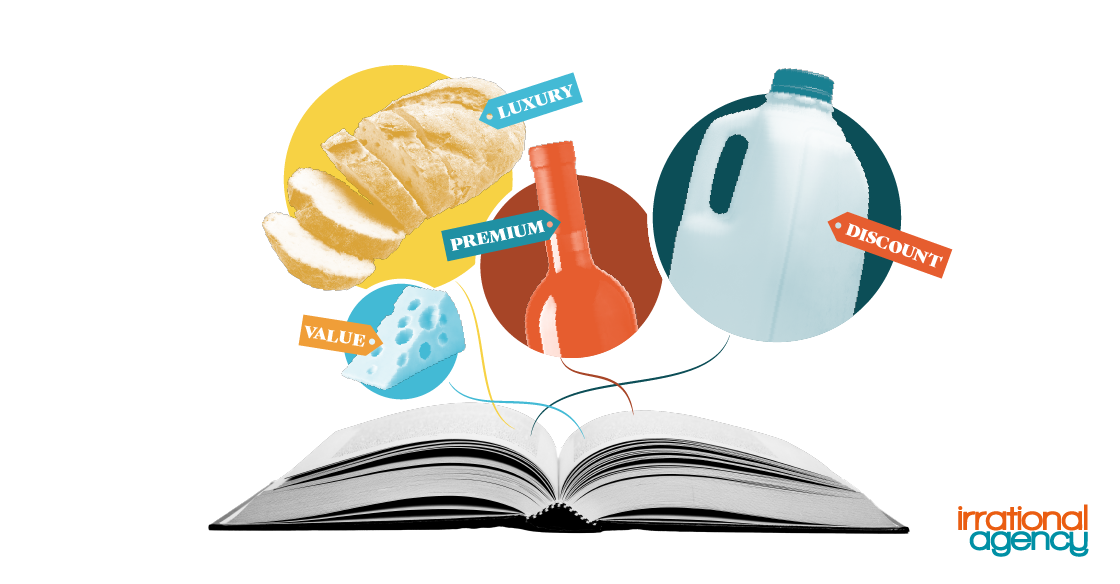
Telling your Cost-of-living Story
 Irrational Agency
Irrational Agency
Supermarkets, restaurants, and food brands all rely on stories to sell their products and services. Even when it comes to something as fundamental as “value” it is the story of that product in the mind of the consumer, how it fits in their life and how they imagine the experience of using it, that is far more important in creating value than factors such as price. It’s by tapping into these consumer stories that we shed light on purchasing decisions that would be otherwise hidden in a traditional survey.
During a cost of living crisis customers have all sorts of personal stories to tell on how they budget for their family, how they might treat their children or how they can save a little bit more each month. These stories are deeper, more influential, and more embedded in the minds of customers than favorable associations with a product slogan or some appealing packaging. Instead, they have background context, wider meaning, and surrounding emotion. To dig into these factors we need to go beyond the rational and use behavioral framework to unlock these hidden currents.
To do this we can use a System 3 methodology that unlocks the sweet spot in between Systems 1 and 2 to provide true future insight. We don’t ask about the past or what they’re doing at the moment, that only gives you answers based on past customer experience, which is insufficient in understanding future behaviors. We ask them to imagine the future, to tell us a story about value. We can then analyze those answers to understand how these narratives will influence their future purchasing behaviors.
Our recent work has demonstrated how these stories can be used to help brands create pricing strategies that will help increase spend, but also build loyalty. Here we outline some of the stories which can be told around good value to capture the imagination of customers. From the meaning of good value to how customers feel when finding discounts.
Crafting Your Story: What Does Good Value Mean for Your Customers
There are varied perceptions and ideas of what constitutes “good value”. For supermarket brands, which aren’t typically “discount” brands, an emphasis on quality can link back to good value. Quality is a challenging attribute to convey prior to experiencing satisfaction with a product. Find ways to demonstrate and show good quality rather than describe it. This can be through the packaging, a point of sale display or through the smell or taste of a product sample.
Setting the Scene: Finding a New Category for Your Good Value Story
Products may be seen as better value depending on the category they sit in. For instance, when considering “Friday night drinks”, a more premium bottle bought from Waitrose is cheaper than the alternative of drinking wine in a bar or restaurant. However, when considering “supermarket wine bottles” a Waitrose wine bottle may be seen as the premium option compared to some competing supermarkets.
When positioning a product as good value, consider what categories it can fit within and where it would be seen as the good value option. Savvy marketing and in store displays can help you switch categories for some products. The premium bottle of wine can be transformed from a never buy luxury product into a substitute for a well deserved weekly treat.
Bringing Your Story to Life: Mixed Pricing Strategies Provide Much Needed Context.
Customers don’t perceive value on its own but within contextualized stories. Price freezes are a strategy used in a cost-of-living crisis because they are intended to give customer reassurance and stability in a time of uncertainty. However, if customers are not expecting prices to increase or believe prices are stable then there is nothing unique or special about a price freeze. Price freezing on its own doesn’t speak to customers but when presented amongst mixed pricing increases and changes it allows price freezing to sit within a context that offers clear relative value.
When using price strategies like “price freezing”, retailers must demonstrate how it fits within the story of cost of living and increasing prices. It is not enough to say you are freezing prices but better to say rather that prices are being frozen amid price increases all around. Making this story clear and bringing it to life makes this strategy effective.
The Satisfying Conclusion
Discounts can give more than their monetary value. Customers should feel good about the discount they have found, they should feel that spotting these discounts is a small win for them. A victorious ending to their purchasing journey.
Making discounts feel like wins can be achieved by showing them within the context of higher prices, applying an unexpected discount for a product where it would not usually apply, or framing the discount as a reward.
Understanding the wider context of consumer behavior and emotional stories opens up ways for us to tell stories to consumers. These are just a few ways our findings can be used to build engaging stories for your brand.
To find out more about our Hidden Stories analysis, and the innovative research methods we used to uncover these stories, watch our webinar here.
